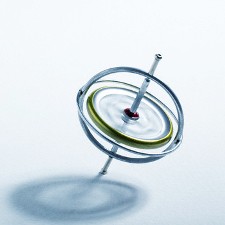Oct 6 2010
Optical gyroscopes, also known as rotation sensors, are widely used as a navigational tool in vehicles from ships to airplanes, measuring the rotation rates of a vehicle on three axes to evaluate its exact position and orientation. Prof. Koby Scheuer of Tel Aviv University's School of Physical Engineering is now scaling down this crucial sensing technology for use in smartphones, medical equipment and more futuristic technologies.
Working in collaboration with Israel's Department of Defense, Prof. Scheuer and his team of researchers have developed nano-sized optical gyroscopes that can fit on the head of a pin - and, more usefully, on an average-sized computer chip - without compromising the device's sensitivity. These gyroscopes will have the ability to pick up smaller rotation rates, delivering higher accuracy while maintaining smaller dimensions, he says. The research was recently described in the journal Optics Express.
 Working in collaboration with Israel's Department of Defense, Prof. Scheuer and his team of researchers have developed nano-sized optical gyroscopes that can fit on the head of a pin.
Working in collaboration with Israel's Department of Defense, Prof. Scheuer and his team of researchers have developed nano-sized optical gyroscopes that can fit on the head of a pin.
"Conventional gyroscopes look like a box, and weigh two or three pounds," Prof. Scheuer explains. "This is fine for an airplane, but if you're trying to fit a gyroscope onto a smaller piece of technology, such as a cellphone, the accuracy will be severely limited."
With laser precision
At the core of the new device are extremely small semi-conductor lasers. As the devices start to rotate, the properties of the light produced by the lasers changes, including the light's intensity and wavelength. Rotation rates can be determined by measuring these differences.
These lasers are a few tens-of-micrometers in diameter, as compared to the conventional gyroscope, which measures about 6 to 8 inches, says Prof. Scheuer. The device itself, when finished, will look like a small computer chip. Measuring a millimeter by a millimeter (0.04 inches by 0.04 inches), about the size of a grain of sand, the device can be built onto a larger chip that also contains other necessary electronics.
Prof. Scheuer and his team of researchers are currently working on lab demonstrators of the device, which he predicts will be ready for testing in a few years' time.
Tracking inside the body
When available, the nano-gyroscopes will improve technologies that we use every day. When you rotate an iPhone, for example, the screen adjusts itself accordingly. A nano-gyroscope would improve the performance of this feature and be sensitive to smaller changes in position, says Prof. Scheuer. And that's not all. Nano-gyroscopes integrated into common cellphones could provide a tracking function beyond the capabilities of existing GPS systems. "If you find yourself in a place without reception, you would be able to track your exact position without the GPS signal," he says.
There are benefits to medical science as well. Right now, small capsules that contain cameras pass through the body during some diagnostic procedures, but to know where the capsule is within a patient, doctors must track its signal from the outside. With the addition of a nano-gyroscope, explains Prof. Scheuer, the capsule would have a built-in navigation system, which would provide the ability to move the capsule to more specific and precise locations within the body.
Source: http://www.aftau.org/